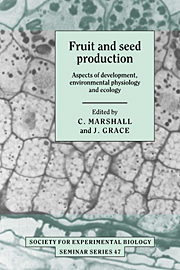Book contents
- Frontmatter
- Contents
- Contributors
- Preface
- Plant reproductive biology: an overview
- The environmental control of reproductive development
- Pollination and fertilization in higher plants
- Embryogenesis
- Environmental and internal regulation of fruiting, with particular reference to Cox's Orange Pippin apple
- Fruit growth and sink strength
- Control of grain growth and development
- The regulation of maternal investment in plants
- Ecological and physiological aspects of reproductive allocation
- Are the distributions of species determined by failure to set seed?
- Edible fruits in a cool climate: the evolution and ecology of endozoochory in the European flora
- Index
The environmental control of reproductive development
Published online by Cambridge University Press: 04 August 2010
- Frontmatter
- Contents
- Contributors
- Preface
- Plant reproductive biology: an overview
- The environmental control of reproductive development
- Pollination and fertilization in higher plants
- Embryogenesis
- Environmental and internal regulation of fruiting, with particular reference to Cox's Orange Pippin apple
- Fruit growth and sink strength
- Control of grain growth and development
- The regulation of maternal investment in plants
- Ecological and physiological aspects of reproductive allocation
- Are the distributions of species determined by failure to set seed?
- Edible fruits in a cool climate: the evolution and ecology of endozoochory in the European flora
- Index
Summary
Environmental control of flowering
The simple observation that many plants flower at a particular season or time of year implies that flowering is influenced and perhaps controlled by changes in the environment. All plants require conditions in which they can grow and develop in order to reproduce and so the ultimate environmental controls are those that determine plant distribution, and the main one may very often be temperature (Grace, 1987). But in all habitats, variations in the environment provide potential cues for the plant to make use of, so that the transition to reproductive growth coincides with the conditions most likely to lead to successful completion of flowering, fruiting and seed dispersal. Even in plants that do not respond to specific environmental changes, the onset and rate of progress of reproductive development will be determined by the general environment of the plant.
Are there any habitats in which the environment is constant and optimum so that growth and reproductive development are governed entirely by factors internal to the plant? The nearest approach to this is probably the tropical forest of SE Asia, which is virtually non-seasonal. However, even here flowering can be controlled by environmental changes, but because these are infrequent, mass flowering is also infrequent. When it does occur, up to 88% of the species may flower simultaneously (Appanah, 1985). The close correlation between an environmental change and subsequent flowering has been shown for the rain forest in Singapore, one of the least seasonal places in the world (Corlett, 1990).
- Type
- Chapter
- Information
- Fruit and Seed ProductionAspects of Development, Environmental Physiology and Ecology, pp. 9 - 32Publisher: Cambridge University PressPrint publication year: 1992
- 6
- Cited by



